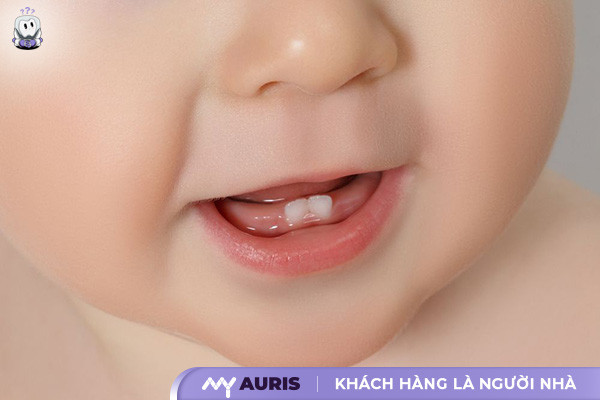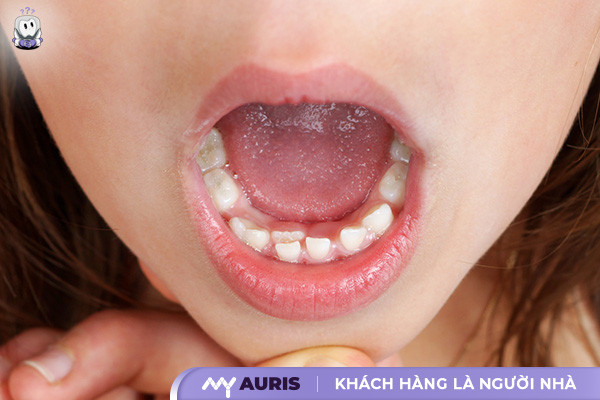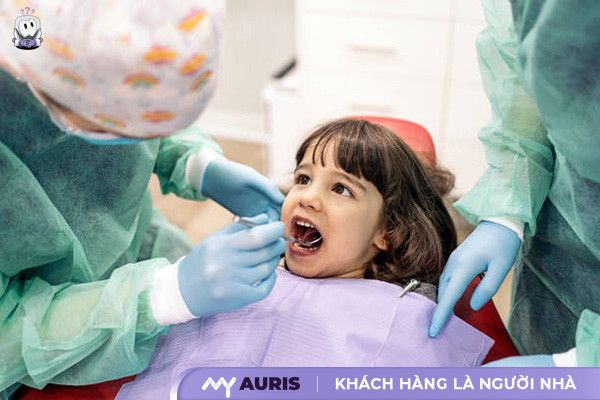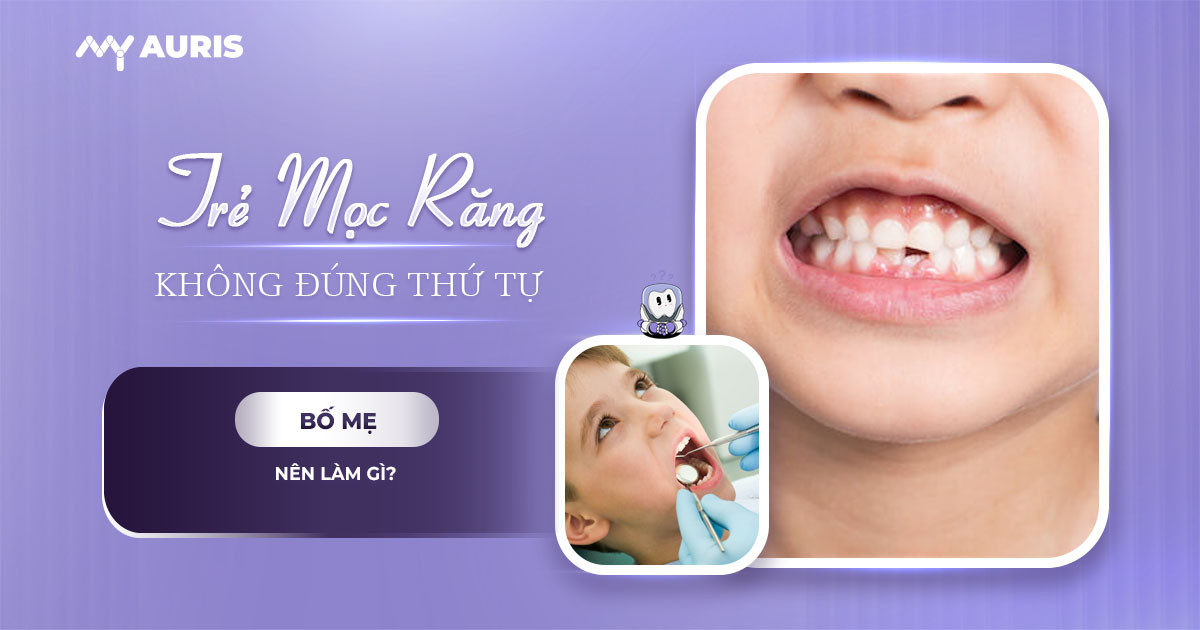It is quite common for children’s teeth to erupt crookedly or out of order, which can affect chewing, jawbone structure, and facial appearance. The primary tooth eruption process mainly occurs within the first two years of life. Properly understanding the tooth eruption sequence and providing good oral care for children helps limit the negative effects of improper tooth eruption, supporting healthy tooth development.
Key Milestones for Primary Tooth Eruption and Eruption Order
Monitoring the order of tooth eruption in children plays a crucial role in timely detection of abnormalities and proper care. To determine if a child’s teeth are erupting normally, parents should be familiar with the eruption timelines and the types of primary teeth that appear at each stage.
6 – 10 Months Old
Children usually begin to erupt their lower central incisors first. These two teeth often emerge simultaneously and in alignment. During this stage, children frequently experience pain, fussiness, and discomfort due to teething. Parents should pay close attention and support their child.
8 – 12 Months Old
Next, the two upper central incisors will appear, also erupting simultaneously and quite evenly.
9 – 13 Months Old
At this point, the two lateral incisors next to the upper central incisors begin to emerge. By this time, the child will have 4 upper incisors and 2 lower incisors.
10 – 16 Months Old
The first two lower molars begin to erupt. These teeth play an important role in chewing soft foods.
16 – 22 Months Old
The baby begins to erupt the upper canines, located between the incisors and molars. These canines help the baby bite and tear food better.
17 – 23 Months Old
The two lower canines will then erupt, further assisting in biting and tearing food.
23 – 31 Months Old
The second two lower molars appear, gradually completing the child’s set of primary teeth.
25 – 33 Months Old
The final two molars erupt, concluding the primary tooth eruption process. In total, a child will have 20 primary teeth, including incisors, canines, and molars.

Reasons Why Children’s Tooth Eruption Sequence Can Be Disrupted
Normally, the tooth eruption process in children follows a specific sequence: starting with the lower incisors, then the upper incisors, followed by the molars and other teeth. However, in reality, not all babies’ teeth erupt in the theoretical order. There are cases where a baby’s molars erupt before the upper incisors, or the upper incisors appear before the lower incisors.
Factors that influence children’s teeth to erupt out of the standard sequence:
Genetic factors: If there’s a family history of irregular tooth eruption (parents, grandparents), there’s a high probability the child will experience a similar situation. Genetics play an important role in determining each child’s tooth eruption process.
Nutrition: An imbalanced diet, especially a deficiency in essential nutrients like calcium, vitamin D, phosphorus, etc., can affect tooth development, disrupting the eruption sequence.
Living environment and external impacts: Children living in polluted environments, exposed to toxic chemicals, or experiencing external impacts such as falls or oral injuries can also lead to teeth erupting out of order.
Congenital conditions: Some congenital conditions related to jawbone structure, endocrine issues, or metabolism can interrupt or alter the normal tooth eruption process in children.

Is It A Concern If Children’s Teeth Erupt Out Of Order?
During the process of children’s tooth eruption, many parents worry when they see their child’s eruption sequence doesn’t match standard charts. However, in reality, this order is not as crucial as other key factors like the spacing between teeth or the ability to prevent oral diseases in children. What’s important is that parents should take their children for regular dental check-ups every 4 months to monitor the condition of their primary teeth and seek early dental advice if they notice any abnormal tooth eruption.
Crooked teeth due to incorrect eruption order can lead to several significant impacts:
Crooked permanent teeth: If primary teeth do not fall out at the correct time due to erupting out of order, permanent teeth are at risk of erupting crookedly, affecting chewing function and aesthetics.
Reluctance to chew, picky eating: Incorrect tooth eruption can cause pain and swollen gums, leading to children being reluctant to chew and picky eaters. In the long term, this situation affects solid food introduction, easily causing nutritional deficiencies and delayed development.
Lisping, incorrect pronunciation: Some sounds, like /l/, require the tongue to touch the upper front teeth. When teeth erupt crookedly or not at the right time, children may have incorrect pronunciation and develop a lisp.
Risk of primary tooth decay, gingivitis: Irregularly erupted teeth overlapping each other make oral hygiene difficult, easily leading to primary tooth decay, gingivitis, and other dental problems.

Methods for Addressing Incorrect Tooth Eruption Sequence in Children
When children are teething, having teeth erupt out of order is a common situation but can have long-term effects on jaw structure and the development of permanent teeth. Since young children cannot recognize abnormalities in the teething process themselves, parents’ observation plays a crucial role. Every minor change in the oral cavity needs to be carefully monitored to determine the appropriate course of action, especially when signs of crooked teeth, misaligned teeth, overbite, or protrusion appear.
Take Your Child for an Early Dental Examination
As soon as signs of incorrect tooth eruption are noticed, parents should take their child to a reputable dental center for a dental examination as soon as possible. There, maxillofacial specialists will conduct a general check-up, analyze the current tooth eruption status, and then propose a suitable intervention plan to limit adverse effects on the development of permanent teeth later on.
Proper Oral Care at Home
Proper oral care during the teething phase is fundamental to helping children develop healthy teeth.
– Oral hygiene: If the baby hasn’t erupted teeth yet, parents should use a gauze pad or a clean cloth dipped in warm water to gently wipe the gums and tongue daily.
– Rinse mouth after night milk: For children who have a habit of drinking milk at night, they should be taught to rinse their mouth with clean water or wipe their teeth and mouth to limit bacterial growth and prevent tooth decay.
Establish a Reasonable Diet
A scientific diet helps support a smooth tooth eruption process for children. It’s essential to increase the intake of calcium, minerals, and fluoride – important nutrients that help permanent teeth become strong and erupt in the correct position. At the same time, limit the child’s consumption of excessive sugar and carbonated drinks, as these can weaken tooth enamel and cause problems with crooked teeth or root damage.
Regular Dental Check-ups for Early Prevention
The habit of taking children for dental check-ups every 6 months not only helps detect early problems like crooked, protruding, or overlapping teeth but also allows for timely adjustment of the eruption direction of permanent teeth. Dentists will provide specific treatment guidelines such as early orthodontics, orthodontic intervention, or lifestyle changes to improve long-term oral health.
Frequently Asked Questions
In addition to worrying about children’s teeth erupting out of order, many parents also have numerous other questions about tooth eruption sequence, eruption speed, and proper oral care for children. Below are answers from dental experts to help parents better understand.
Does it matter if upper or lower teeth erupt first?
Typically, a child’s tooth eruption sequence starts with the lower jaw teeth, followed by the upper jaw teeth. However, some babies may not follow this order. In reality, the speed and timing of tooth eruption vary for each child, depending on their maxillofacial bone structure and genetic factors. What’s important is for parents to closely monitor the teething process and take their child to a dentist if any unusual signs are detected, to receive appropriate guidance on oral care.
Is Crooked Primary Tooth Eruption A Cause for Concern?
Crooked primary teeth not only cause aesthetic issues but also pose a potential risk of tooth decay and gingivitis, affecting the child’s chewing ability. More dangerously, if not intervened early, permanent tooth buds may erupt crookedly, leading to underbites, deep bites, and affecting the jawbone structure and facial appearance later on.
Why Is Early Orthodontic Screening Important?
Dental experts recommend that parents take their children for orthodontic screening from 6–7 years old. This is an ideal time for the dentist to examine the maxillofacial bone structure, tooth bud positions, and the eruption direction of permanent teeth. Early detection of abnormalities will allow for timely intervention, limiting bite problems and helping the child develop a confident smile later on. At the same time, this also helps save significant treatment time and costs.
We hope the information above has helped parents better understand the situation of children’s teeth erupting out of order, as well as how to identify and promptly address issues related to upper jaw teeth, lower jaw teeth, and crooked primary teeth, thereby effectively protecting the child’s jawbone structure and chewing function.





